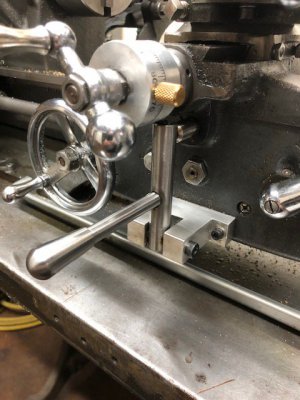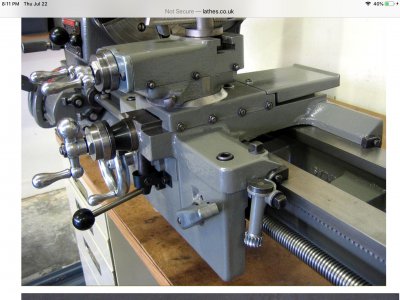-
Welcome back Guest! Did you know you can mentor other members here at H-M? If not, please check out our Relaunch of Hobby Machinist Mentoring Program!
You are using an out of date browser. It may not display this or other websites correctly.
You should upgrade or use an alternative browser.
You should upgrade or use an alternative browser.
Help with my Atlas Lathe
- Thread starter ZouchaR
- Start date
With regard to changing the pull-out knob to the lever operated power cross feed: This was a change installed on the final (second) version of the 1/2" bed 12" Atlas and Craftsman machines. The first version appears to have used the same cross-feed parts as did the Atlas 10F and the Craftsman 101.07403, 101.27430 and 101.27440. Consequently, the only changes to the apron may have been been drilling and tapping two holes to mount the lever hinge and possibly machining flats around the holes. As you probably already know, there is a gear on the cross feed shaft. It is the same 10F-33 part in all of the power cross feed machines. The gear on the shaft with the pull-out knob on it has a Clausing style part number and the number of teeth is not given. However, there is no apparent reason for them to have changed the diameter or tooth count so it could be the same size as on the earlier machines. There is some evidence that some part numbers were changed to Clausing style without actually changeing how the part was made. They also apparently made the lever operated gear and shaft as one piece but the gear appears to be the same size.
So it may be that all that you need to do to convert from the pull-out knob to the lever operated power cross feed could be to find the parts, drill and tap two holes, and bolt it together. I will have to check that I got them back but I may have the necessary parts. I can call Clausing and see whether they will release the drawing of the final version of the apron that will show where to drill and tap the two holes.
So it may be that all that you need to do to convert from the pull-out knob to the lever operated power cross feed could be to find the parts, drill and tap two holes, and bolt it together. I will have to check that I got them back but I may have the necessary parts. I can call Clausing and see whether they will release the drawing of the final version of the apron that will show where to drill and tap the two holes.
Last edited:
Circa 1966-06 March 1981
Unfortunately, we don't know the final Atlas serial number, other than that it was an Atlas 3996 and was greater than 106781. The one shown in your photo is probably a 3986, made from 1966 though Summer, 1974.
Unfortunately, we don't know the final Atlas serial number, other than that it was an Atlas 3996 and was greater than 106781. The one shown in your photo is probably a 3986, made from 1966 though Summer, 1974.
Last edited:
The other two improvements made to the models made during the final 15 years were a slip clutch in the lead screw to take the place of the frangible right lead screw bearing and an improved right bearing with needle thrust bearings.
These improvements may have been what prompted Sears to call it the "Commercial" model.
These improvements may have been what prompted Sears to call it the "Commercial" model.
Now.. This Atlas is running on 110V.. but it really has NO GUTS... I can not do much more than a 3 thousands cuts, even on Cast Iron.. It has the original Atlas motor which is 220V Capable.. what do I need to do to switch this lathe over to 220V... And will that help my situation?? HELP!!
Last edited:
Something is wrong. Mine has plenty of guts with the original Atlas 1/2 hp motor running on 110 V.
Does your motor actually slow down and/or stall? It is not that a belt is slipping?
You are not powering it through a 100' long 18 AWG extension cord, correct?
Does your motor actually slow down and/or stall? It is not that a belt is slipping?
You are not powering it through a 100' long 18 AWG extension cord, correct?
It will actually draw the motor down to a stop.. and the belts are not slipping.. I mean there is always some amount of minor slip that you really can't detect in all belt driven tools... but since it will draw the motor down to a dead stop.. the belts are not the issue.. What happens as these motors get older??? Do they lose some of their horsepower?? And no. this is wired into a standard wall outlet that we wired using code approved wiring..Something is wrong. Mine has plenty of guts with the original Atlas 1/2 hp motor running on 110 V.
Does your motor actually slow down and/or stall? It is not that a belt is slipping?
You are not powering it through a 100' long 18 AWG extension cord, correct?
Now.. This Atlas is running on 110V.. but it really has NO GUTS... I can not do much more than a 3 thousands cuts, even on Cast Iron.. It has the original Atlas motor which is 220V Capable.. what do I need to do to switch this lathe over to 220V... And will that help my situation?? HELP!!
Yeah, voltage isn’t the problem. You should be able to take .020-.030 no problem.
Rigidity in your ways and tool post, belt slippage, tool alignment, tool geometry and proper sharpening have a really big impact on depth of cut.
Once you have confirmed all is good there is speeds and feeds that matter as well.
Of course another member mentioned voltage drop, but I doubt that is what is happening given that it looks like you have power in your shop close nearby to your lathe.
EDIT: sorry didn’t see your reply on the voltage. Your motor could be bad.
Sent from my iPhone using Tapatalk
I am trying to turn down a lathe chuck adapter for my 4 jaw chuck.. it is cast iron, so it should be fairly soft.. I am using insert tooling with new inserts and the tool height has been checked. I have a QCT that appears to be solid. I CAN NOT even think about using auto feed because it literally stops the motor. I touched off.. and then turned in less than a quarter turn on the cross slide.. and it will bog the motor down almost instantly when the tool touches the work.. you can hear it drag the motor down...Yeah, voltage isn’t the problem. You should be able to take .020-.030 no problem.
Rigidity in your ways and tool post, belt slippage, tool alignment, tool geometry and proper sharpening have a really big impact on depth of cut.
Once you have confirmed all is good there is speeds and feeds that matter as well.
Of course another member mentioned voltage drop, but I doubt that is what is happening given that it looks like you have power in your shop close nearby to your lathe.
Sent from my iPhone using Tapatalk


